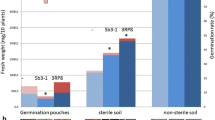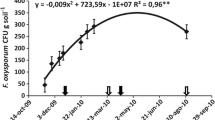Abstract
In earlier studies, biological control of Fusarium wilt of cucumber induced by Fusarium oxysporum f. sp. cucumerinum was demonstrated using nonpathogenic strains C5 and C14 of Fusarium oxysporum. Strain C14 induced resistance and competed for infection sites whether roots were wounded or intact, whereas strain C5 required wounds to achieve biocontrol. In the current work, additional attributes involved in enhanced resistance by nonpathogenic biocontrol agents strains to Fusarium wilt of cucumber and pea were further investigated. In pre-penetration assays, pathogenic formae specials exhibited a significantly higher percentage of spore germination in 4-day-old root exudates of cucumber and pea than nonpathogens. Also, strain C5 exhibited the lowest significant reduction in spore germination in contrast to strain C14 or control. One-day-old cucumber roots injected with strain C14 resulted in significant reduction in germ tube orientation towards the root surface, 48–96 h after inoculation with F. o. cucumerinum spores, whereas strain C5 induced significantly lower spore orientation of the pathogen and only at 72 and 96 h after inoculation. In post-penetration tests, passive transport of microconidia of pathogenic and nonpathogens in stems from base to apex were examined when severed plant roots were immersed in spore suspension. In repeated trials, strain C5, F. o. cucumerinum and F. o. pisi were consistently isolated from stem tissues of both cucumber and pea at increasing heights over a 17 days incubation period. Strain C14 however, was recovered at a maximum translocation distance of 4.6 cm at day 6 and later height of isolation significantly declined thereafter to 1.2 cm at day 17. In pea stem, the decline was even less. Significant induction of resistance to challenge inoculation by the pathogen in cucumber occurred 72 and 96 h after pre-inoculation with biocontrol agents. Nonetheless, strain C14 induced protection as early as 48 h and the maximum resistance was reached at 96 h. The presented data confirm the previous findings that attributes important for nonpathogenic fusaria to induce resistant are: rapid spore germination and orientation in response to root exudate; active root penetration and passive conidia transport in stem to initiate defence reaction without pathogenicity and enough lag period between induction and challenge inoculation. Strain C14 possesses all these qualifications and hence its ability to enhance host resistance is superior than strain C5.
Similar content being viewed by others
References
Agrios GN. Plant Pathology, 4th ed. Academic Press, 1997
CT Paulitz CS Park R Baker (1987) ArticleTitleBiological control of Fusarium wilt of cucumber with of nonpathogenic isolates of Fusarium oxysporum Can J Microbiol 33 349–353
CL Biles RD Martyn (1989) ArticleTitleLocal and systemic resistance induced in watermelons by formae speciales of Fusarium oxysporum Phytopathology 79 856–860
Q Mandeel R Baker (1991) ArticleTitleMechanisms involved in biological control of Fusarium wilt of cucumber with strains of nonpathogenic Fusarium oxysporum Phytopathology 81 462–469
RP Larkin DL Hopkins FN Martin (1996) ArticleTitleSuppression of Fusarium wilt of watermelon nonpathogenic Fusarium oxysporum and other microorganisms recovered from a disease-suppressive soil Phytopathology 83 812–819
C Alabouvette B Schippers P Lemanceau PA Bakker (1998) Biological control of Fusarium wilts: Towards development of commercial products GJ Boland LD Kuykendall (Eds) Plant–Microbe Interactions, Biological Control Marcel Dekker New York 15–36
JR Bao G Lazarovits (2001) ArticleTitleDifferential colonization of tomato roots by nonpathogenic and pathogenic Fusarium oxysporum strains may influence Fusarium wilt control Phytopathology 91 449–456
S Freeman A Zveibil H Vintal M Maymon (2002) ArticleTitleIsolation of nonpathogenic Fusarium oxysporum f. sp. melonis for biological control of Fusarium wilt of cucurbits Phytopathology 92 164–168
RP Larkin DR Farvel (2002) ArticleTitleEffects of varying environmental conditions on biological control of Fusarium wilt of tomato by nonpathogenic Fusarium spp Phytopathology 92 160–1166
Q Mandeel AY Gamal El-Din SA Mohammed (1994) ArticleTitleAnalysis of SDS-dissociated proteins of pathogenic and nonpathogenic Fusarium species Mycopathology 127 159–166 Occurrence Handle1:CAS:528:DyaK2MXivFWgt7g%3D
Mandeel Q. Induction of resistance to Fusarium wilt by strains of nonpathogenic Fusarium oxysporum. (Abstr.) Sixth Arab Congress of Plant Protection. 1997: 292 pp
CS Park CT Paulitz R Baker (1988) ArticleTitleBiological control of Fusarium wilt of cucumber resulting from interactions between Pseudomonas putida and nonpathogenic isolates of Fusarium oxysporum Phytopathology 78 190–194
Q Mandeel ZM Hassan MA El-Meleigi R Baker (1994) ArticleTitlePenetration and colonization of cucumber roots by pathogenic and nonpathogenic Fusarium oxysporum Phytopathol Mediterr 33 137–145
Q Mandeel (1996) ArticleTitleIntegration of biological and chemical control of Fusarium wilt of radish J Plant Dis Protect 103 610–619
RG. Steel JH. Torrie (1980) Principles and Procedures of Statistics McGraw-Hill New York 632
C Gessler J Kuc (1982) ArticleTitleInduction of resistance to Fusarium wilt of cucumber by root and foliar pathogens Phytopathology 72 1439–1441
L. Sequeira (1990) Induced resistance: Physiology and Biochemistry R Baker P Dunn (Eds) New Directions in Biological Control Alan R. Liss New York 663–678
RP Baayen AL Maat ParticleDe (1987) ArticleTitlePassive transport of microconidia of Fusarium oxysporum f. sp. dianthi in carnation after root inoculation Neth J Plant Pathol 93 3–13 Occurrence Handle10.1007/BF01998138
DM Elgersma (1970) ArticleTitleLength and diameter of xylem vessels as factors in resistance of elms to Ceratocystis ulmi Neth J Plant Pathol 76 179–182 Occurrence Handle10.1007/BF01974328
Author information
Authors and Affiliations
Corresponding author
Rights and permissions
About this article
Cite this article
Mandeel, Q.A. Influence of Plant Root Exudates, Germ Tube Orientation and Passive Conidia Transport on Biological Control of Fusarium Wilt by Strains of Nonpathogenic Fusarium oxysporum. Mycopathologia 161, 173–182 (2006). https://doi.org/10.1007/s11046-005-0211-2
Received:
Accepted:
Issue Date:
DOI: https://doi.org/10.1007/s11046-005-0211-2




